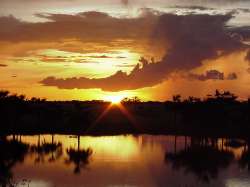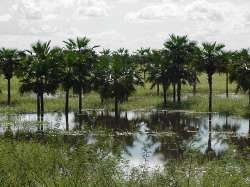
Situated in a picturesque valley on the north coast, Venezuela's capital is a bustling metropolis of nearly 5 million inhabitants. Fast, progressive and cosmopolitan, the city retains little of the character of its colonial roots. While it boasts some of the most impressive modern architecture in South America, Caracas is also home to a vast expanse of ranchos - sprawling slums of tin sheds and carddboard boxes covering the surrounding hills that are the product of the uncontrolled surge of postwar immigration.
Sights include Plaza Bolívar, with its 17th-century cathedral; the Casa Natal de Bolívar, birthplace of Simón Bolívar; Santa Capilla, a 19th-century neo-Gothic church modeled on Paris's Sainte Chapelle; the monumental Palacio de Miraflores, palace of former leader Joaquín Crespo; the sacred Panteón Nacional, where many eminent Venezuelans are interred; the Petares district, which has retained its historic colonial character; and the modern, bustling Parque Central, which provides a taste of modern Caracas.
Most of the budget hotel accommodations are in the less salubrious suburbs, which are not always safe, especially at night. The best is probably Sabana Grande. Be sure to always keep your wits about you, as mugging and petty theft have become rife in recent years.
Nightlife tends to be centered around the districts of Las Mercedes, El Rosal, La Floresta and La Castellana. Enjoy a beer at the Greenwich Pub, or catch some jazz at the Juan Sebastián Bar, one of the city's few authentic jazz venues.
Since the 1950s, Caracas' population has soared from around 400,000 to almost five million. The city suffered a severe economic decline in the 1980s and '90s, and the thousands of rural dwellers who rushed to find wealth in the big metropolis now lead a precarious hand-to-mouth existence in the ramshackle huts that cover the steep hills surrounding the city center. Theft and armed robbery are increasingly a fact of life. Worse was to come on December 15, 1999, when disastrous mudslides devastated a 100km (62mi) swathe of the Litoral Central, the coastal area just north of Caracas. The exceptionally high rainfall that caused the disaster is estimated to occur only once in a thousand years in this region. Believed to be South America's worst natural disaster in recent memory, the mudslides killed between 30 and 50 thousand people, and made 150,000 homeless. Entire beaches and shantytowns vanished, the colonial town of La Guaira - once the region's major cultural sight - was destroyed, and the resorts are now ruined ghost towns.
http://www.venezuelatuya.com/caracas/index.htm
http://www.lonelyplanet.com/dest/sam/ven.htm
The verdant mountains of the Sierra Nevada de Mérida are the northernmost tip of the Andes range, and lie in the northwestern reaches of Venezuela. Dotted with small villages whose inhabitants still follow a traditional lifestyle, the mountain also sports trails that reward the more adventurous and energetic traveler with stunning views of the snowcapped peaks. The pleasant, friendly town of Mérida, nestled in the mountains just 12km (7mi) from the country's highest peak, Pico Bolívar, is one of Venezuela's most popular tourist destinations.
http://www.venezuelatuya.com/andes.htm
The northeast coast is the place to go for outdoor activities such as snorkeling, scuba diving, fishing, sailing or just lying around and enjoying the sun. The county's beaches are at their idyllic best here - long expanses of white sand lapped by turquoise waters and fringed with coconut palms. Isla de Margarita, 40km (25mi) from the mainland, is a favorite for beach-lovers and a popular holiday destination for Venezuelans. It is easily accessible by ferry from Cumaná and Puerto La Cruz on the mainland.
http://www.venezuelatuya.com/morrocy/index.htm
The Amazon region in the south of the country is thick with tropical rain forest, crisscrossed by rivers, and home to a number of isolated Indian tribes. Tours up the Orinoco, Sipapo, or Autana rivers and deep into the Venezuelan Amazon can be arranged from the hot but pleasant town of Puerto Ayacucho.

One of the most beautiful regions in Venezuela is Los Llanos. These are huge plains full of beautiful fauna and wildlife. Take care to protect the many micro-ecosystems that exist in this region. Conservation projects are underway but much destruction has already been done.

River in the Hato La Fe en Corozopando.
In this region there are only two very different seasons, rainy or dry. During the rain season the woods, rivers, and trees show their beauty. A large part of the region is under the water. In the dry season, the plant life becomes yellow and brown, and the dust covers most part of the plains. The difference between the two seasons is so big, that you can't say that you know the "llanos" if you don't go in both periods.

Summer is the dry season and is the best time for animal viewing, as the birds, amphibians, and mammals must go to the few existing watering holes. In winter, the rainy season, it is more difficult to travel by road due to the flooding, in however the plants and fauna are spectacular.
For more information and pictures click on http://www.venezuelatuya.com
http://www.interknowledge.com/venezuela/history.htm
Click photo to return to main page.